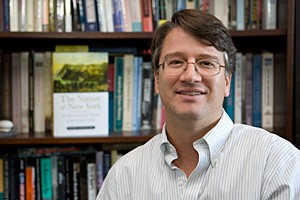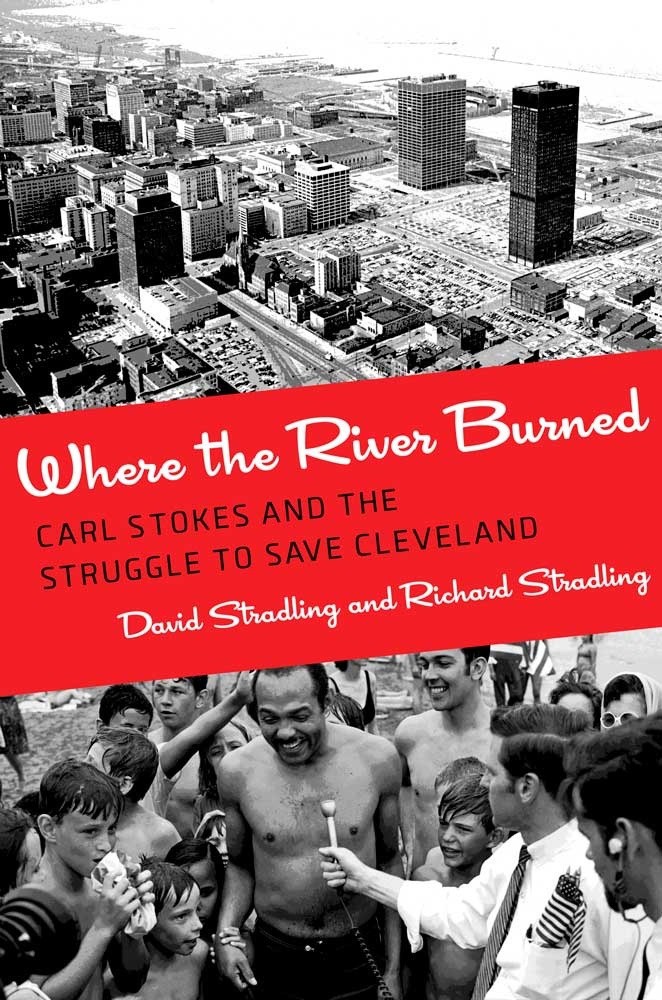Historian Pathfinds for Emerging Generation of Urban Environmentalists
Dr. David Stradling’s blend of historical, urban and environmental perspectives leads to guest co-editorship of respected Kentucky journal.
Date: 8/26/2017 12:00:00 PM
By: Jonathan Goolsby
Contact: Julie Campbell-Holmes
Phone: (513) 509-1114
Photos: University of Cincinnati, Cornell University Press
CINCINNATI, Oh. — In Flint, Michigan, is there lead in the water because the schools are failing, or are the schools failing because there’s lead in the water?
That’s a question that urban environmental historians like Dr. David Stradling, the University of Cincinnati’s Associate Dean for the Humanities and a professor in its History Department, hope to answer.
“For decades, sociologists and urban historians treated the urban environment as a setting,” Stradling posited: “‘These are failed neighborhoods where bad social outcomes happen.’”
“The field of environmental history itself has been a little slow to recognize the connections between environmental stresses in cities — poverty, educational outcomes, economic outcomes — it’s all interwoven,” he said.
As the United States — its Midwestern and Southern Rust Belt in particular — continues to struggle with industrial decline, increasing economic disparity and environmental challenges, a more holistic evaluation of our history may be needed.

Prof. David Stradling
Replace with your As the United States — its Midwestern and Southern Rust Belt in particular — continues to struggle with industrial decline, increasing economic disparity and environmental challenges, a more holistic evaluation of our history may be needed.
Indeed, one might argue that environmental problems go unaddressed due to a polarized political climate that has arguably been born of those same three factors.
“What environmental history can do,” Stradling explained, “is to recognize how much the environment is actually contributing to the failure of that place.”
Mixing urban and environmental historical inquiries, he said, “allowed me to connect the urban and environmental stories more thoroughly.”
“This is one of those areas in which traditionally-trained environmental historians will walk into a city and act like traditionally-trained environmental historians, which is to say they’ll look for nature,” he clarified. “They’ll look for how people interact with nature in the cities, for how people protect nature in the cities, for how they reconstruct nature in the cities. And all of these are really important topics.”
An urban-specializing environmental historian, though, will focus less on how greenspace and living things are pushed out of —or intentionally re-introduced into — cities, and focus instead on how living things are fundamentally changed by urbanization.
“You might end up writing about the same topic, but asking different questions about it, depending on your training.”
“How do urban residents interact with their total environment?,” Stradling asked. “The category of natural or artificial is, for most people, not really an important one if you’re concerned about air quality, the quality of the water that comes out of your tap, about lead paint inside the home, lead poisoning in the soil of your yard.”
“All of these boundaries between nature and culture,” he emphasized, are “so thoroughly mixed and unimportant that environment is really the category that matters. Not nature.”
An unexpected path
Stradling didn’t set out to become an urban environmental historian. He began his academic career studying colonial American history. But, as so often happens in liberal arts settings, a particularly exciting professor re-shaped his interests.
While a Master’s student at the University of Wisconsin, Stradling took a class with that institution’s urban historian. That course was interesting enough to him that he switched his concentration. Later, he returned to Cincinnati (his hometown) to write his thesis.
“I thought I could do an environmental urban topic,” he remembered. “My advisor up in Madison told me to come talk to Zane Miller.”
Those conversations with his future UC History colleague proved fateful.
“Zane turned me on to [writing about] controlling coal smoke,” Stradling said. “He knew that there was an active movement here in Cincinnati that hadn’t been covered.”
Impressed by the late professor’s counsel, he returned to UC for an entire year as a visiting scholar during his doctoral candidacy at Wisconsin. In 2000, he returned once again — as a tenure-track hire.
Although his primary specialty remains urban history, he has, over the course of his career, consistently blended his urban history scholarship with environmental history.

Where the River Burned (2015)
His latest book, Where the River Burned: Carl Stokes and the Struggle to Save Cleveland, published by the Cornell University Press in 2015, explored the complex set of political, economic and environmental circumstances that contributed to the Cuyahoga River fire in the late 1960s.
That incident, along with several other high-profile ecological disasters in the mid-20th Century, led to nationwide calls for environmental reform and culminated in overwhelming bipartisan Congressional support — and an override of then-President Richard Nixon’s veto — for the Clean Water Act of 1972.
But, Stradling said, the opportunity for scholarship doesn’t begin and end with environmental reforms. The Stokes administration, he noted, “dealt with really devastating environmental challenges at a time when it was also experiencing deindustrialization, racial strife, struggles over desegregating schools,” and loss of capital re-investment to suburban sprawl.
Cleveland, Stradling said, “was experiencing a diminishment of its ability to solve problems just when it was experiencing this incredible confluence of problems.”
Just such hamstringing continues in Cleveland and in many other post-industrial American communities. And, as other scholars have shown, the problem has spread from the cities to the rural heartland.
Environmental history, blended with other niche understandings, offers the opportunity to discover the roots of these complex failures and develop better policies.
“The feedback loop becomes much more prominent,” Stradling said. “I think we get a better sense for how social problems become endemic to place, because these places have been constructed through social failure.
Scholarship that transcends politics and geography.
Stradling’s work has attracted enough attention that he was tapped, by the Register of the Kentucky Historical Society’s editor, David Turpie, to co-guest edit (along with the University of Maine’s Dr. Richard W. Judd) that journal’s Spring, 2017, issue: “Environment and Environmentalism in Kentucky.”
That might have surprised some. Why would the Kentucky Historical Society turn to outside academics to lead an exploration of the Commonwealth’s environmental history?
After all, this is a state with a rich body of environmental literature — a place which produced agrarian novelists Wendell Berry and Gurney Norman, environmentally-conscious poets like Silas House, and Erik Reece’s seminal text on the devastation coal mining has caused to Middle Appalachia’s water sources and ecological systems.
But, excepting Reece, most examinations of Kentucky’s environment have proceeded under the mantle of creative writing. Few scientific inquiries specifically focusing on Kentucky’s environment have been published, Stradling noted; fewer still incorporate the full historical context of the problems they look at.
“Mountaintop removal — we know a lot about that story. Surface mining is partly a Kentucky story that we know pretty well,” he said. “Outside of that, there’s very little [on the] environmental history of the state of Kentucky. So, there’s a lot of potential there.”
Although environmental history has become a hotter topic for Southern scholars in recent decades, particularly vis-à-vis environmental changes associated with the antebellum South’s King Cotton economy (consider the litany of texts on “Agriculture and Slavery's Impact on the Land” listed here).
But environmental scholarship about the so-called Border States region “is kind of a gapper,” Stradling asserted.
“Kentucky, Tennessee and West Virginia? They’re just not Southern enough,” he observed. “They don’t really have that plantation economy that Southern historians are interested in, so they get left out of a lot of that mainstream Southern history.”
“There’s not a really good history of the Ohio River — one of the most important rivers in the world. Just hasn’t been done yet,” Stradling lamented.
“States are not containers of any real environmental boundaries,” he said. “We’re more connected to Kentucky by the Ohio River than we are divided by it.”
Stradling believes that there is strong opportunity for students to extend scholarship that blends historical niches, that develops more robust understandings of our complex region and world.
“The interest of the Register of the Kentucky Historical Society in environmental history is a sign of the maturity of the field,” he said, smiling.